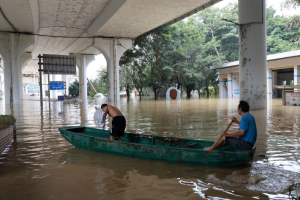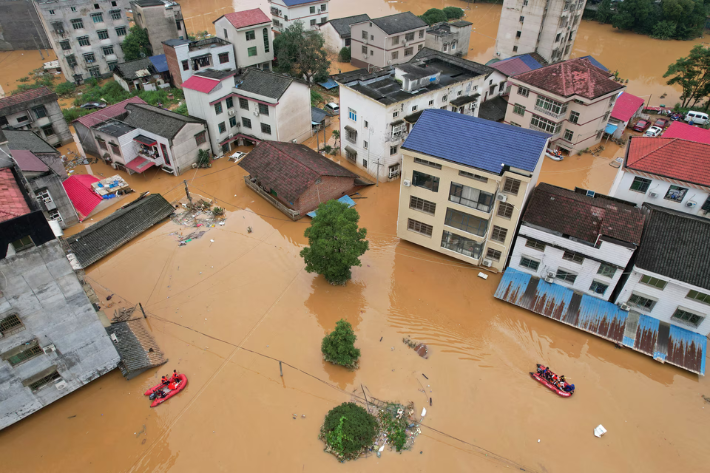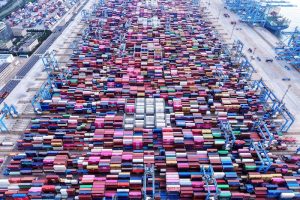With just the first half of the year gone, China is already counting losses totalling many billions as climate change-related extreme weather events and other natural disasters rock the country.
Over the past six months, the world’s second-largest economy saw extreme temperatures, torrential rains and unprecedented floods and droughts.
Those events, coupled with a 7.1 magnitude earthquake in northwestern Xinjiang and landslides in southwestern regions, have so far caused China a direct economic loss worth 93.16 billion yuan ($12.83 billion), according to government data released on Friday.
Also on AF: Conflicting Goals Could Limit Outcomes From China’s Plenum
This is the worst first-half disaster-related loss China has borne since 2019, according to details available on China’s Emergency Management Ministry website.
The impact was also far worse than the year-earlier period, when China logged losses of 38.23 billion yuan — about a third of current year’s figures.
Some 856,000 people faced emergency resettlement and 23,000 houses were destroyed this year, while around 3.17 million hectares of crops were affected.

Overall, at least 32.38 million people were affected by natural disasters during the period, including the disappearance or death of 322 people.
In comparison, about 48.76 million people were affected due to natural disasters for all of 2023, according to the ministry’s report from last year.
China has channelled $575 billion into disaster management so far this year, according to a Reuters tally. Some $75 billion of that total was allocated last month for agricultural production and disaster relief.
A typhoon of extreme climate
Floods since June have ravaged key manufacturing bases across China, hitting Hefei city, an industrial powerhouse in the east, and Guangdong province in the south. Guangdong accounted for a tenth of China’s GDP last year, according to CGTN.
Southern Chinese states have been some of the worst hit by torrential rains, triggering floods and landslides in Fujian, Guangxi, Zhejiang and Hunan, aside from Guangdong.
Meanwhile, northern and some eastern states in the country are experiencing drought brought on by some of the year’s hottest weather. Average temperatures from March to May hit their highest since records began in 1961, according to official data.

The dramatic swings between extreme heat and intense rainfall have stressed China’s power grids and shut factories, while risking the country’s water security and causing widespread crop damage.
This was also not the only time this year that floods hit Guangdong — the province once dubbed the “factory floor of the world”. In April, too, record-breaking rains flooded the province.
In the same month, rare storms with typhoon-like winds engulfed the southern Jiangxi province. Three people died after they were blown out of their high-rise apartments in their sleep after intense gusts ripped door-size windows off frames in their apartments. The storms were accompanied by dramatic sheet lightning, pounding rain and hailstones the size of golf balls.
While winds of such intensity are common when typhoons make landfall they are rarely found inland such as in landlocked Jiangxi.
Meanwhile, early in the year, cold waves, blizzards and icy rain also hit large parts of China — leading at one point to a 100-car pile-up in export hub Suzhou.
Rougher roads ahead
Government estimates suggest China’s climate crisis is not likely to subside any time soon.
Early this month, China’s weather bureau warned the country was facing hotter and longer heatwaves and more frequent and unpredictable heavy rain as a result of climate change.
In its annual climate “Blue Book”, the China Meteorological Administration (CMA) warned that maximum temperatures across the country could rise by 1.7-2.8 degrees Celsius within 30 years, with eastern China and the northwestern region of Xinjiang set to suffer the most.

Yuan Jiashuang, vice-director of the CMA’s National Climate Centre, warned that if emissions remained high, extreme heat events expected to occur once every 50 years in China could happen every other year by the end of the century, and rainfall could double and become more unpredictable.
Ironically, despite those concerns, China has not seen any domestic public debate about how it can mitigate climate change.
Chinese state media and officials have been increasingly reluctant to link the ongoing climate crisis to China’s own emissions – around a third of the global total.
Instead, many state media outlets have focused on China’s leadership in the fight against climate change and called for developed countries to take more responsibility.
- Reuters, with additional inputs from Vishakha Saxena
Also read:
Critical China Factory Hubs Face Greatest Climate Change Risk
China Misses 2023 Emissions Targets, ‘Climate Credibility at Risk’
Study Shows Half of China’s Big Cities Sinking, Rising Seas Risk
China Building More Solar, Wind Than Rest of World Combined
Fossil Fuel Phase-Out ‘Unrealistic’, China Climate Chief Warns
China Cities Miss Air Quality Goals as Economy ‘Prioritised’
China Must Pay Up For Climate Damage, Says Germany
Work on New Coal Plants Raises Doubt on China’s Climate Vows
Global Warming Rocks the Qinghai-Tibet Plateau – China Dialogue
























